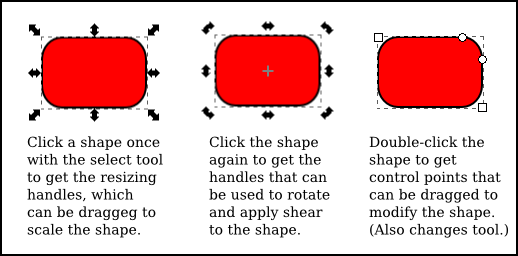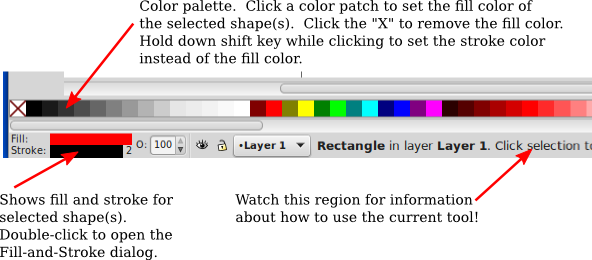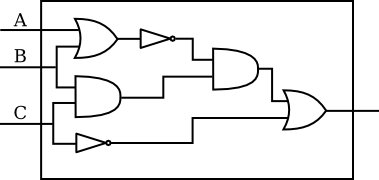CS 424, Fall 2015:
Inkscape: A 2D "Drawing" Program
This lab is a very brief introduction to the free 2D vector drawing program, Inkscape. The lab is based on Inkscape 0.48, the version installed on our Linux computers. Inkscape is available for Windows and Mac OS, as well as for Linux. For more information, see its home site, inkscape.org. A very useful user manual can be found at http://tavmjong.free.fr/INKSCAPE/MANUAL/html/index.html.
Inkscape uses SVG as its graphics format. SVG, or Scalable Vector Graphics, is discussed in Section 2.7 of our textbook. SVG images can be opened in many standard image viewers and can be used on the Web. Inkscape adds some extra data to the svg files that it creates, but that data will be ignored by other programs. Note that to open an svg file with Inkscape on our Linux computers, you have to right-click the file and use "Open With" / "Inkscape".
Remember that your work with the Gimp program is due today (September 28). Your exercises should be in a folder named gimp in your homework folder.
Assignment
There are three exercises in this lab. To turn in your work, you should submit your files in a folder named inkscape in your homework folder in /classes/cs424/homework. The files should have names such as ex1.svg or exercise3.svg. As with the Gimp assignments, The grading will be along the lines of: "Not done" for an F; "Minimal effort and incomplete" for a D; "Minimal effort" for a C; "Acceptable" for a B; or "Excellent" for an A. I will look for your work one week after the lab, on Monday, October 5.
The Interface
You can find Inkscape in the "Graphics" section of the Start menu. Inkscape runs in
a single window, with a large central drawing area and several toolbars around the edges.
Many dialog boxes, such as the one for setting stroke and fill properties, will open
along the right edge of the window. The layout is very configurable; my discussion
assumes the standard layout.
can find Inkscape in the "Graphics" section of the Start menu. Inkscape runs in
a single window, with a large central drawing area and several toolbars around the edges.
Many dialog boxes, such as the one for setting stroke and fill properties, will open
along the right edge of the window. The layout is very configurable; my discussion
assumes the standard layout.
The drawing area probably shows a scaled-down view. I prefer to work with a full size drawing, so the first thing I usually do is hit the "1" key to get an unscaled view. For detailed work, magnified views are also useful; you can get them using the "View" menu.
The Inkscape toolbar runs along the left edge of the window. The tools that you are most likely to use in this lab are labeled in the illustration. You can also get a description of the tool by hovering your mouse over it. (The same is true for most interface elements.) It's a good idea to learn some of the keyboard equivalents, such as F1 for the select tool.
The drawing tools, for creating shapes, are the Rectangle, Ellipse, Star/Polygon, Spiral, Bezier, and Text tools.
The select tool is only useful after you've drawn some items. Click on an item with the select tool to select it. Select multiple items by dragging a box around them with the select tool. You can also add items to the selection by shift-clicking them. When multiple items are selected, you can manipulate them as a group. For example, you can drag the group to a new position, or you can resize the group as a whole. You can use the "Group" command in the "Object" menu to permanently group the selected items into a compound item; you can break up a compound item using the "Ungroup" command.
When you select an item, or group of items, handles appear around the item. You can drag the handles to transform the selection. There are actually two sets of handles, as well as the possibility of modifying the shape by dragging "control points." For example, using a rectangle:

For a rectangle, the small round control points can be dragged to make rounded corners. The control points also appear when you first draw the shape. To make them go away, you can switch to the Select Tool.
A shape in Inkscape can be stroked and/or filled. There is a dialog box for setting stroke and fill properties, which you can get by right-clicking a shape and selecting "Stroke and Fill" from the popup menu. The dialog box has tabs for setting the stroke and the fill colors. There is also a "Stroke Style" tab, where you can set the stroke width and other attributes. There is a shortcut for setting colors, using the "Color Palette" near the bottom of the window:

A status bar, under the color palette, contains information about the currently selected shape and the currently selected tool. You can learn a lot about how to use Inkscape by paying attention to the help text in this status bar!
Above the drawing area, you can find a tool options bar, whose content changes depending on which tool is selected. In the options for the Select Tool, for example, you'll find some icons for rotating and flipping the current selection, and for moving the selection up or down in the ordering in which the shapes are drawn. Hover your mouse over an icon to find out what it does. Again, paying attention to the options toolbar can help you learn how to use Inkscape! Here is part of the option toolbar for the Star/Polygon tool:

Exercise 1: Use Inkscape to make a drawing containing at least six shapes created using the Star/Polygon tool. Learn how to use the tool by reading the status information at the bottom of the window and by investigating the options toolbar for the Star/Polygon tool. Your shapes should show a wide variety! You should try to demonstrate all the possible options. You should also apply several different fill and stroke styles to the shapes.
Bezier Paths
The most versatile shape tool is the Bezier tool, which lets you draw both polygonal paths and Bezier curves. I have found it easiest to start with a polygonal path, which you can make by clicking one or more points along the path, then double-clicking the final point. Inkscape refers to the points that you click as "nodes." For example to make a straight line segment, click one endpoint, then double-click the second endpoint.
Once you have the polygonal path, switch to the Control Point Editing Tool (F2) to modify the shape. (You might need to click a shape with that tool, to begin editing it.) With that tool, you can drag the middle of a line segment to make it into a curve. You can also drag the path's nodes. When you click the node at an end of a curved segment, handles will appear, and you can drag the control points at the ends of the handles to adjust the shape. (This is all very much like editing Bezier paths in the Gimp.) You should note these four button icons in the options toolbar for the Control Point Editing Tool:
![]()
Click one of these buttons while a node is selected to set how the handles for that node work. The left button allows you to freely adjust the two handles separately. This is the default setting. With that setting, you get a sharp point or corner. The second button forces the control points and the node to lie on a line, giving a shape that is smooth at that node. The third button makes an even smoother shape by forcing the two control handles to have the same length.
Exercise 2: Use Inkscape to draw a logic circuit diagram, similar to the one shown below. You can use the Text tool for the letters and the Rectangle tool for the rectangular border of the circuit. You can use the Ellipse tool for the small circle on the tip of the NOT gate. The other parts of the circuit should be created using the Bezier tool.

You will need to create an AND gate, an OR gate, and a NOT gate. (You only need one of each; after that, you can use Copy-and-Paste to make more.) The gates are symmetric. The Bezier tool does not make it easy to make symmetric shapes. To make it easier, I suggest that you turn on the grid, using the "Grid" command in the "View" menu. The grid is not part of your drawing; it just helps you to position things, including Bezier curve nodes and handles.
Other Features
Exercise 3: For the third and final exercise, you will make an Inkscape drawing that uses several additional features of the program. The drawing should contain the two specific items described below and at least one additional item.
One of the items should be "text on a curve." The idea is to make a curve using the Bezier Tool, then make a line of text that follows the curve. Type in the text anywhere in the drawing using the text tool. Then...

After you put the text on the curve, you can still edit the text and the curve separately. When you are happy with the result, select the curve and turn off its stroke color to make it invisible.
The second item is a shape that consists of a perfect square subtracted from a perfect circle, with the square exactly in the center of the circle. How to get perfect circles instead of ellipses? Read the help text at the bottom of the window! Same for perfect squares. To get the two shapes perfectly aligned, select both shapes and use the "Align and Distribute" command in the "Object" menu. This brings up a very useful dialog box containing a number of buttons that you can use to align and distribute the selected items in various ways. Finally, to subtract one shape from another, select both shapes and use the "Difference" command in the "Path" menu. (Note that the upper shape is subtracted from the lower, which means that you should draw the square after you draw the circle.) Once you have the combined shape, set its fill color. The region between the square and the circle should be filled, as shown in the following picture. I added a blue rectangle in the background so that you can see that there's actually a square hole in the circle, not simply a white square on top of a red circle.

The third item for the drawing is up to you, but it should be something that uses another feature of Inkscape. One option is to use a gradient fill, made using the Gradient Toll. Another option is to try a couple of the items in the "Filter" or "Extensions" menu. Actually, most of the filters don't seem to be very good, but you might want to play around with them. One idea: drag a small image from the file system onto your drawing. It will be added as an item in the drawing. Then apply a black outline (the very first filter in the menu) and a drop shadow to the image. Better yet, be creative!